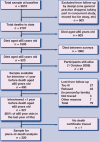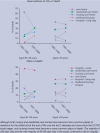Place of death for the 'oldest old': > or =85-year-olds in the CC75C population-based cohort
- PMID: 20353663
- PMCID: PMC2845508
- DOI: 10.3399/bjgp10X483959
Place of death for the 'oldest old': > or =85-year-olds in the CC75C population-based cohort
Abstract
Background: Deaths are rising fastest among the oldest old but data on their transitions in place of care at the end of life are scarce.
Aim: To examine the place of residence or care of > or =85 year-olds less than a year before death, and their place of death, and to map individual changes between the two.
Design of study: Population-based cohort study.
Setting: Cambridge City over-75s Cohort (CC75C) study, UK.
Method: Retrospective analysis of prospective data from males and females aged > or =85 years at death who died within a year of taking part in any CC75C survey (n = 320); death certificate linkage.
Results: Only 7% changed their address in their last year of life, yet 52% died somewhere other than their usual address at the time of death. Over two-thirds were living in the community when interviewed <1 year before death, but less than one-third who had lived at home died there (less than one-fifth in sheltered housing). Care homes were the usual address of most people dying there (77% in residential homes, 87% in nursing homes) but 15% of deaths in acute hospital came from care homes.
Conclusion: More than half the study sample of individuals of advanced old age had a change in their place of residence or care in their last year of life. These findings add weight to calls for improved end-of-life care in all settings, regardless of age, to avoid unnecessary transfers. The study data provide a baseline that can help plan and monitor initiatives to promote choice in location of care at the end of life for the very old.
Figures




References
-
- Davies E, Higginson I. World Health Organization. Better palliative care for older people. Copenhagen: WHO Europe; 2004.
-
- Department of Health. End of life care strategy: promoting high quality care for all adults at the end of life. London: Department of Health; 2008.
-
- Department of Health. Living well with dementia: a National Dementia Strategy. London: Department of Health; 2009.
-
- National Council for Palliative Care. Out of the shadows: end of life care for people with dementia. London: National Council for Palliative Care; 2009.
-
- National Audit Office. End of life care. London: House of Commons; 2008.
Publication types
MeSH terms
LinkOut - more resources
Full Text Sources
Research Materials
